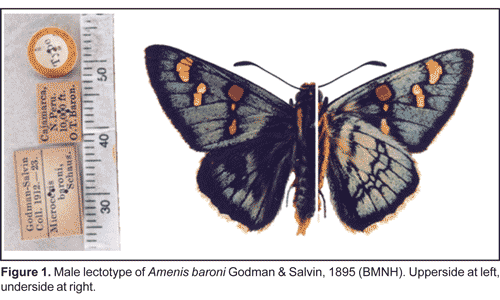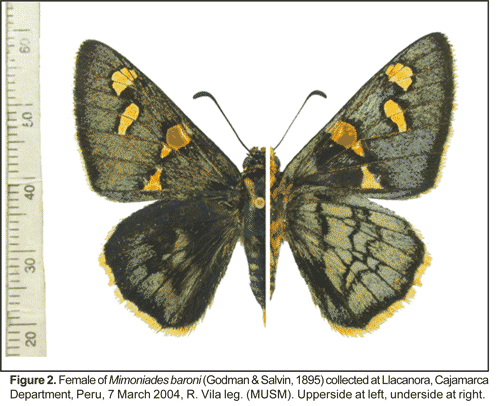Services on Demand
Journal
Article
Indicators
-
 Cited by SciELO
Cited by SciELO
Related links
-
 Similars in
SciELO
Similars in
SciELO  uBio
uBio
Share
Revista Peruana de Biología
On-line version ISSN 1727-9933
Rev. peru biol. vol.11 no.1 Lima Jan./July 2004
NOTA CIENTÍFICA
Redescubrimiento de Mimoniades baroni (Godman & Salvin, 1895) (Lepidoptera: Hesperiidae: Pyrrhopyginae)
Gerardo Lamas 1 and Roger Vila 2
1 Museo de Historia Natural, Universidad Nacional Mayor de San Marcos.
2 Museum of Comparative Zoology, Harvard University.
Presentado: 03/05/2004
Aceptado: 21/05/2004
Abstract The rediscovery of Mimoniades baroni (Godman & Salvin, 1895) (Lepidoptera: Hesperiidae: Pyrrhopyginae), in Cajamarca, Peru, is reported herein. The species had not been recorded since its original description, almost 110 years ago.
Keywords: Amenis baroni, Cajamarca, conservation, Peru.
Resumen
Se reporta el redescubrimiento de Mimoniades baroni (Godman & Salvin, 1895) (Lepidoptera: Hesperiidae: Pyrrhopyginae), en Cajamarca, Perú. La especie no había sido registrada desde su descripción original, hace casi 110 años.
Palabras clave: Amenis baroni, Cajamarca, conservación, Perú.
Mimoniades baroni was described as a new species over a century ago by British zoologists Frederick DuCane Godman [1834-1919] and Osbert Salvin [1835-1898] as Amenis baroni (Godman & Salvin, 1895). It was based on an unstated number of male and female individuals, which had been captured by German naturalist and traveller Oscar Theodor Baron [1847-1926] «...near Cajamarca [in Northern Peru] at an altitude of 10,000 feet above the sea.» Godman & Salvin assigned their new species to the then recently described genus Amenis Watson, 1893, which included only two species, originally placed within Pyrrhopyge Hübner, [1819], occurring in Colombia and Venezuela (P. pionia Hewitson, 1857; and P. ponina Herrich-Schäffer, 1869).
Godman & Salvin (1895) stated that Amenis baroni was structurally similar to Pyrrhopyge pionia, the type species of Amenis, but differed by characters of wing coloration, wing venation, and male genitalia. The female was «...similar to the male, but rather larger and with more rounded wings.» No date of capture or any biological information accompanied the original description.
No mention of Amenis baroni was made by Mabille (1903-4) in his monographic treatment of the Hesperiidae, but the species was later transferred to the genus Mimoniades Hübner, 1823, without explanation, and in an innacurate way, by Mabille & Boullet (1908), who credited the name M. baroni solely to Salvin, and mentioned examining one male specimen from «Equateur» in the collection of Paul Dognin [1856- ?]. Presumably, this is the specimen recorded as «Pyrrhopyge ponina» by Dognin (1887, 1891) from the area of Loja. The whereabouts of this particular specimen is unknown, as it has not been located in the National Museum of Natural History, Smithsonian Institution, Washington DC (USNM), which holds a large part of Dognin's collection (Robbins, pers. comm.). A few years later, Mabille (1912) listed Mabille & Boullet (sic!) as authors of M. baroni, with «Ecuador» as the type locality (!). Draudt (1921), obviously without having seen any specimens, repeated the misleading information given by Mabille & Boullet (1908) and Mabille (1912). Bell (1933), also without having seen any specimens, returned the species to Amenis, with no explanation. Williams & Hayward (1944) adopted the same view. In his revision of the American Hesperiidae, Evans (1951) stated that the collections of the British Museum (Natural History) in London (BMNH) contained 98 males and 94 females of Amenis baroni (including the male «type»), from «Cajamarca, Peru», all presumably collected by Baron. One of us (GL) has examined part of that type series, and has ascertained that all were captured by Baron, some of the specimens bearing the date «May 1894», whereas others (including the putative «type» mentioned by Evans) have no date of capture. Lewis (1973) illustrated a specimen (as Amenis baroni), mentioning its distribution as «Peru». Finally, Mielke & Casagrande (2002) returned A. baroni to Mimoniades, where it stands now, claiming that the species exhibits all the traits that characterize that genus.
It appears that not all of the 192 specimens of M. baroni mentioned by Evans (1951) as being extant in the BMNH, were seen by Godman & Salvin at the time they first described the species, and probably the type series was considerably shorter. For instance, the Museo de Historia Natural, Universidad Nacional Mayor de San Marcos, Lima (MUSM), holds one male and one female of M. baroni, which were donated by the BMNH. The male belonged to L. W. Rothschild's collection, and bears a label indicating that it was collected by Baron in Cajamarca, in May 1894, whilst the female belonged to the collection of P. Crowley and is labelled as having been collected May 12th, «near Cajamarca» though neither year nor collector are indicated. Likewise, two males and two females, ex Rothschild's collection, were donated to the collections of the Department of Zoology, Universidade Federal do Paraná, Curitiba, Brasil (DZUP) (Mielke, pers. comm.). Evans' (1951) mention of a male specimen in the BMNH as the «type» of Amenis baroni cannot be regarded as an instance of correct lectotypification, as he did not select unambiguously a particular syntype from the original type series. Therefore, in order to restrict the original type series, we designate as lectotype of Amenis baroni, to represent the unique bearer of the name, the male specimen presumably listed by Evans (1951) as the «type», and which is illustrated herein (Fig. 1).

On March 7, 2004 one of us (RV) collected two females of M. baroni, and briefly saw a third individual, at the outskirts of the town of Llacanora, in Cajamarca, at 2720m (S 07°11'07.5, W 078°25'27.8), which lies only some 10 km E of the city of Cajamarca (at 2800m, S 07°09', W 78°31'). The specimens were captured on an elevated place by the Quebrada Shaullo, past the second waterfall upstream, and along the path that connects Llacanora with the little village of Shaullo Chico. This uncultivated spot was in a dry and open area with scarce and short vegetation. The surrounding landscape was deeply altered by human activity, including agricultural areas, sheep and cow grazing, and Eucalyptus plantations. Both specimens were collected at noon, under rather sunny although windy conditions, within about ten minutes. They were flying in the direction of the wind and both stopped to extensively libate some big composite flowers that grew individually scattered in the area. The preference of M. baroni for these conspicuous yellow or orange flowers was evident. One female (Fig. 2) is deposited in the collections of MUSM, while the other, with the body preserved in 100% ethanol and the wings in a separate envelope, is deposited at the Museum of Comparative Zoology, Harvard University, Cambridge (MCZ), DNA and Tissues Collection (sample code: RV-04-I-434).

Acknowledgements
The expedition that led to the rediscovery of M. baroni was made possible by Naomi E. Pierce (MCZ) and by a Putnam Foundation Expedition Grant. RV was funded by a Fulbright Postdoctoral Fellowship. We thank Mark Cornwall (MCZ) for his help as field assistant in the Cajamarca region and for reviewing the text. We also thank warmly Olaf Mielke (DZUP) and Robert K. Robbins (USNM) for their comments on the present paper.
Literature cited
Bell, E. L. 1933. Studies in the Pyrrhopyginae, with descriptions of new species (Lepidoptera, Rhopalocera, Hesperiidae). Journal of the New York entomological Society 41(3): 265-295. [ Links ]
Dognin, P. 1887. Note sur la faune des lépidoptères de Loja et environs (Equateur). Paris, Imprimerie Alcan Lévy. 24 pp., 2 pls. [ Links ]
Dognin, P. 1891. Lépidoptères de Loja et environs (Equateur). Descriptions d'espèces nouvelles. Paris, Imprimerie F. Levé. 2: 27-65, pls. 3-6. [ Links ]
Draudt, M. 1921. B. Grypocera, breitköpfige Tagfalter. In: Seitz, A. (Ed)., Die Gross Schmetterlinge der Erde. Stuttgart, Alfred Kernen. 5: 836-856. [ Links ]
Evans, W. H. 1951. A catalogue of the American Hesperiidae indicating the classification and nomenclature adopted in the British Museum (Natural History). Part I. Introduction and Group A Pyrrhopyginae. London, British Museum (Natural History). x + 92 pp., pls. 1-9. [ Links ]
Godman, F. D. & O. Salvin. 1895. On a new species of Hesperiidae of the genus Amenis, Watson. Annals and Magazine of natural History (6)15(88): 372-373. [ Links ]
Lewis, H. L. 1973. Butterflies of the World. Chicago, Follett. xvi + 312 pp., 208 pls. [ Links ]
Mabille, P. 1903-1904. Lepidoptera Rhopalocera. Fam. Hesperidae. Genera Insectorum 17: 1-210, pls. 1-4. [ Links ]
Mabille, P. 1912. Fam. Hesperidae. Subfam. 1: Pyrrhopyginae. Lepidopterorum Catalogus 9: 3-18. [ Links ]
Mabille, P. & E. Boullet. 1908. Essai de révision de la famille des hespérides. Annales des Sciences naturelles (Zoologie) (9) 7 (4/6): 167-207, pls. 13-14. [ Links ]
Mielke, O. H. H. & M. M. Casagrande. 2002. Notas taxonômicas em Hesperiidae neotropicais, com descrições de novos taxa (Lepidoptera). Revista brasileira de Zoologia 19(Supl. 1): 27-76. [ Links ]
Williams, R. C. & K. J. Hayward. 1944. Hesperiidarum rei publicae aequatoris catalogus. Acta zoologica Lilloana 2(1): 63-246. [ Links ]
Correspondencia
1 Museo de Historia Natural, Universidad Nacional Mayor de San Marcos, Apartado 14-0434, Lima-14, Perú. E-mail Gerardo Lamas: glamasm@unmsm.edu.pe
2 Museum of Comparative Zoology, Harvard University, 26 Oxford St., Cambridge, MA 02138, USA. E-mail Roger Vila: rvila@fas.harvard.edu













